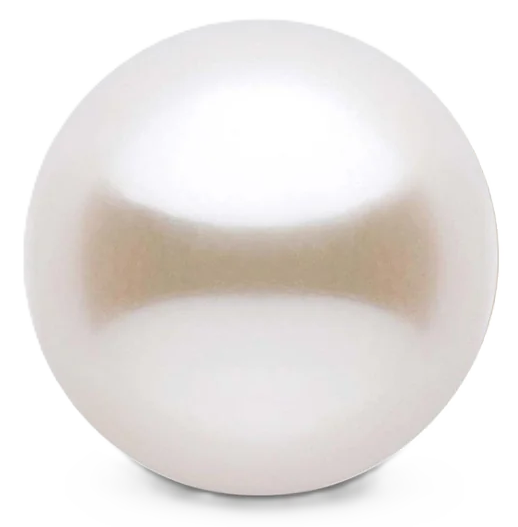
The word pearls comes from Old French perle, likely derived from the Latin perna (a sea mussel). In older texts you may also see:
- Margarite / Margarita (from Greek margaritēs, “pearl”)
- Oriental pearl (traditional term for natural saltwater pearls)
- Mother-of-pearl (nacre; the iridescent shell lining from which pearls are formed)
Composition, Physical Characteristics & Varieties
- Composition: Microlayers of aragonite (CaCO₃) platelets bound by conchiolin and water.
- Structure: Concentric, onion-like layers create lustre and orient (soft rainbow iridescence).
- Hardness: ~2.5–4.5 on the Mohs scale (soft; easily scratched).
- Specific gravity: Typically ~2.6–2.8.
- Stability: Sensitive to acids, heat, cosmetics, perfume, and dehydration.
Main Varieties (by origin & appearance)
- Natural pearls: Formed without human intervention; exceptionally rare today.
- Cultured pearls: Nucleated or tissue-nucleated in farms; the global standard. Key types:
- Akoya: Classic round, high-lustre whites and creams (Japan, China).
- South Sea: Large, satin lustre; white, silver, champagne, and golden (Australia, Indonesia, Philippines).
- Tahitian: Famous black/peacock tones (French Polynesia).
- Freshwater: Wide shapes/colours; from button to baroque (chiefly China).
- Keshi: All-nacre, naturally seedless “happy accidents” with intense lustre.
- Mabe (blister): Hemispherical pearls grown against the shell interior.
- Baroque: Non-round, sculptural shapes; beloved in contemporary jewellery.
Where Pearls Are Found
Historically important fisheries include the Persian/Arabian Gulf, Red Sea, and Gulf of Mannar (India/Sri Lanka). Modern cultured production thrives in Japan and China (Akoya, freshwater), French Polynesia (Tahitian), Australia, Indonesia and the Philippines (South Sea), with additional farming in Myanmar, Vietnam, and Micronesia.
Archaeological & Significant Finds, Historical & Current Usage
- Antiquity: Pearls graced Persian, Greek and Roman elites; they were tributes, temple offerings and imperial regalia. Roman writers rhapsodised about their prestige; one legend tells of Cleopatra dissolving a pearl to win a wager on the costliest banquet.
- Silk Road & Islamic Golden Age: Pearls moved along trade routes into Byzantium, India and China, adorning crowns, reliquaries and ceremonial dress.
- Renaissance & Baroque Europe: Baroque pearls inspired whimsical en tremblant jewels and saintly reliquaries.
- Modern era: In the early 20th century, cultured pearls revolutionised availability and pricing, bringing pearls to a much wider audience. Today, pearls range from heirloom strands to avant-garde designs pairing baroque shapes with gold, silver or leather.
Interesting Facts
- Pearls are among the few organic gemstones (with amber, coral, jet and ivory).
- Their famed “orient” arises from light interference across ultra-thin aragonite layers.
- Pearls dehydrate over time if stored too dry—traditional advice: “pearls should be worn; skin humidity keeps them happy.”
- Unlike most gems, pearls require no cutting or polishing to reveal their beauty.
Folklore, Superstition, Legends & Tales
- In many cultures pearls symbolise purity, wisdom, and tears—hence Victorian “tears of joy” in bridal sets.
- Eastern lore links pearls to dragons and the moon, representing spiritual perfection.
- European sailors carried pearls for protection at sea and calm waters.
- Bridal superstition varies: some say pearls bring tears; others claim they absorb sorrow so the marriage begins cleansed.
Mystical Healing Properties (non-medical, spiritual use)
- Emotional balance: Soothing to turbulent feelings; encourages grace under pressure.
- Nurturing & self-worth: Supports compassion, receptivity, and honest self-regard.
- Calming the mind: Favoured for easing overthinking and promoting serene presence.
- Physical folklore: Traditionally associated with fluids and cycles (hydration, skin glow, hormonal ebb/flow).
Note: These uses are spiritual/complimentary and not a substitute for professional care.
Astrology & the Zodiac
- Ruling luminary: The Moon (soft light, tides, intuition).
- Primary sign: Cancer—home, security, emotional intelligence.
- Also resonant with: Pisces (empathy, dreamwork) and Libra (poise, harmony).
- Vedic perspective: Pearl (mukta) is worn to strengthen the Moon in the birth chart—traditionally set in silver and worn near the skin.
Chakras
- Heart Chakra (Anahata): Compassion, forgiveness, gentle openness.
- Crown Chakra (Sahasrara): Quiet connection to higher guidance and cyclical wisdom.
- Some practitioners also place pearls at the Throat Chakra to encourage soft, truthful communication.
Birthstone & Wedding Anniversary
- Birthstone: June (alongside Moonstone and Alexandrite).
- Wedding anniversary: 30th—the Pearl Anniversary, symbolising matured love and enduring beauty.
Crystal Pairings: What Works Well & What to Avoid
Works Beautifully With
- Moonstone & Selenite: Amplify lunar calm, intuition and cleansing.
- Rose Quartz & Morganite: Deepen self-love, gentleness and emotional healing.
- Aquamarine & Larimar: Sea-linked serenity; clear, compassionate voice.
- Mother-of-Pearl & Opal (gentle varieties): Heighten receptivity and creative flow.
- Clear Quartz: A neutral amplifier that preserves pearl’s softness.
Use Cautiously or Avoid
- Very intense activators (e.g., Moldavite, Black Obsidian, Cinnabar) can overwhelm pearl’s subtle energy for sensitive wearers.
- Vedic astrology caution: Pearl (Moon) is traditionally not combined with stones for Saturn (Blue Sapphire), Rahu (Hessonite/Gomed) or Ketu (Cat’s Eye) unless guided by a competent astrologer, due to energetic incompatibility.
- If you enjoy stronger pairings, introduce gradually and notice how you feel.
Care, Storage & Buying Tips (Quick Guide)
- Last on, first off: Avoid perfumes, hairspray, acids and heat.
- Wipe after wear: Soft, slightly damp cloth; no ultrasonic or steam cleaners.
- Store softly: In a fabric pouch, away from harder gems/metals; avoid airtight boxes—pearls like a little humidity.
- Restring regularly: Knotted silk or specialised thread; check frequently if worn often.
- Look for: Even, mirror-like lustre, pleasing surface, and secure drill holes; value factors include size, shape, lustre, surface quality, nacre thickness, and matching on strands.
